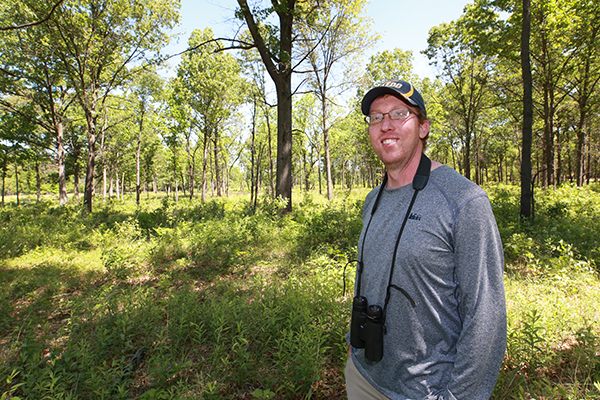Toledo region is a bird magnet
Ornithologists, birders, naturalists, conservationists band together for avian community
By Laurie B. Davis
In less than a month, northwest Ohio will become a birder’s paradise.
Thousands of songbirds, visible at eye level within a seven-acre area at Magee Marsh, are so abundant and colorful that “they look like Christmas tree ornaments,” says naturalist Dr. Christine Manzey (BA Ed ’77, MS A/S ’85, PhD Ed ’10), an Oak Openings resident in Whitehouse, Ohio.
When the wood warblers and other bird species descend on Lucas and Ottawa counties in early May, as they do each year, they can draw as many as 60-to- 70,000 bird watchers from around the world. The Black Swamp Bird Observatory and its many supportive, conservation partners have successfully marketed the birding festival known as The Biggest Week in American Birding. This year’s festival is from May 4 to 13.
Birders come in all ages and with different levels of knowledge about birds. Their interests in birds vary widely. Serious birders come to check off species from their lists, others value their beauty and are fascinated by their behaviors, while some love their songs. No matter what native residents or visitors love about the birds they come out to see in the Toledo region each May, bird enthusiasts want bird populations sustained and their habitats protected. An alumna of The University of Toledo, a retired UT professor and a current UT professor are working to that end through science, conservation and environmental advocacy.

Some of America’s iconic organizations dedicated to land conservation and the protection of wildlife, the Audubon Society and the National Geographic Society, have made birds their top priority in 2018, naming it The Year of the Bird. The designation coincides with the 100th anniversary of the oldest wildlife protection law, The Migratory Bird Treaty Act of 1918. The recurring question throughout the literature has been ‘why do birds matter?’
no images were found
Streby notes that beyond economics, birds matter in our world for many reasons. The most obvious, he says, is how changes in their health and demography can warn of future environmental harm for humans. “Anybody can claim their research involves the proverbial canary in a coal mine, but only ornithologists can do it with actual canaries,” says Streby.
Ornithologist Dr. Elliot Tramer, a retired University of Toledo professor of biology, and a naturalist like Manzey, his wife, says, if environmental changes cause bird populations to crash, that’s an immediate indicator of far-reaching environmental factors. “DDT is a prime example of that,” says Tramer, pointing to the harmful class of chemicals known as chlorinated hydrocarbons that interfered with bird reproduction in the 1970s, including that of bald eagles. Banned in 1972, DDT was an effective pesticide that indicated future harmful effects for humans, brought to light in Rachel Carson’s book, “Silent Spring.”
Inquisitive nature

Streby’s most recent migration research on the golden-winged warbler will eventually produce, he says, about 15 papers. Already, this work has been published in the Proceedings of the National Academy of Sciences journal. “This project was a major undertaking to address one big question about where the birds go and how that might explain their historical population trends and inform their future conservation,” says Streby. What they found in this study is that the location where golden-winged warblers spend the winter in the tropics determines if a population is declining or stable, not factors associated with the birds’ breeding grounds in North America.
The added value of this study was a chance to collect extra data. When funding is limited and birds are abundant, he and his team of graduate students take advantage of every opportunity to collect more data. “When my lab has funding for any project, big or small, we make a point to do what we call the ‘while you’re there’ science.” Because the golden-winged warbler project involved hundreds of birds in 20-plus sites across eastern North America, his team also collected feather and claw samples to assess color, condition and diet. They took blood samples to assess immune function, genetics and genomics, says Streby. “And we recorded songs to look at local and regional variation. All of those samples are with collaborators at several other labs, and the initial results suggest it was a very good idea to collect all the data we could.”
As the research results on golden-winged warblers gather momentum, Streby also has other conservation projects under way. A new study that will hit its stride this summer is one that looks at distribution, density and demography of spotted turtles, eastern box turtles and red-headed woodpeckers in oak savannas of Ohio and Michigan.
Over the past few decades, the Nature Conservancy, the Department of Natural Resources in Ohio and in Michigan, and Toledo Metroparks have put substantial effort into restoring and conserving oak savanna and wet prairie habitats, says Streby. “We’re excited to have the opportunity to assess the current status of that work in terms of how well those areas support turtle and woodpecker populations. The three, target species are all of special conservation concern, and the hope is that these management and restoration efforts are providing areas for them to have stable and productive populations,” he says.
Streby will be working with three graduate students, a postdoctoral researcher, and his wife, Dr. Jeanine Refsnider, assistant professor of environmental sciences at UT and co-principal investigator of the project. “Just like with our other work, our goal is to provide information that will help land managers continue what is working and adjust anything that could be improved to benefit the wildlife community,” says Streby.
An Attraction to Oak Openings
While Oak Openings serves as an outdoor laboratory for Streby, it’s home to Manzey and Tramer, who, both in retirement, contribute to the livelihood of birds through plant conservation as master gardeners, doing bird censuses, and volunteer work on the Whitehouse Tree Commission and the Black Swamp Bird Observatory. Tramer served on the BSBO board for nine years and was chair of the research committee. He also leads tours in the Oak Openings during The Biggest Week in American Birding event. Manzey, who taught science at Notre Dame Academy in Toledo, volunteers to assist with registration at the event.
no images were found
“The Biggest Week has gotten so popular, and so many people are all trying to get into the one seven-acre woods up on the lakefront where the warblers are often abundant. With literally thousands of people coming in May now, we really try to spread people out. Two buses come out to Oak Openings,” says Tramer. “What we’ve discovered is that people can come to the Oak Openings and see birds that they’re not going to see on the East side of town. Oak Openings has got this unique property, and even as an ornithologist I still don’t understand it, but somehow the Oak Openings attracts birds that aren’t normally in northwestern Ohio. If you look in a bird guide, it says that bird doesn’t nest here, but they do.
“So, people want to see things like blue grosbeaks or summer tanagers; these are southeastern U.S. birds. If you look at a bird guide that shows a range map, they don’t show blue grosbeaks in this area at all, but we have them. So somehow the Oak Openings sucks these birds out of the sky.” The bottom line, says Tramer, is that birders can come and see as many as two dozen kinds of birds that they’re not as likely to see on the East side of Toledo.
Manzey says of The Biggest Week that birders can come with an incredible list of bird species and they’re likely to be able to tick them off that list. By coming over to the Oak Openings tours, birders will maximize their species lists. “They want to see as many bird species as possible. So, they can come here and add more; there’s not a lot of overlap. There’s a different set of birds here.”
Tramer says over four to five days in May, birding in the Toledo area allows people to see as many as 150 species. “Thirty of them would be warblers.”
Sharing the Data
Tramer and Manzey know their birds. They are frequent travelers to remote areas of Central America such as Panama and Costa Rica, and they’ve recently been to Cuba. They go to see unique tropical birds but also to see “their” birds from Oak Openings when they’re wintering in the tropics.
Tramer did research in Costa Rica in Monteverde in the mid-1970s to study neo-tropical migrants. “These birds have entirely different lives when they’re in the tropics than when they are here. Some that we know are strictly insect eaters, are eating fruit when they’re there,” says Tramer. “The eastern kingbird—it’s a bird that isn’t social and eats insects here, and when it’s in the tropics it’s flying around in big flocks and eating fruits in the canopy of the forest.
“No one knew what these birds were doing when they left. It’s like they flew to the moon. I was fortunate to get an NSF (National Science Foundation) grant to fund that trip, and then more people began looking at the same behaviors,” he says.
no images were found
As a member of the BSBO’s research committee, Tramer and his fellow members have worked toward getting the organization to share its data with researchers. “BSBO has a tremendous opportunity because they’ve been banding birds since about 1992. In the same place, using the same protocol, which is important in a long-term study because consistency allows them to spot trends. BSBO has this data set, but they weren’t doing a lot with it.”
The challenge has been that there’s so much data, says Manzey. “This is where we’d like more professors who have graduate students to carve out pieces. They need projects for their PhDs and there are so many questions that could be asked.”
Luckily, Streby has such a student. Annie Crary, who is a UT doctoral candidate, is on the board of the BSBO and is a master bird bander who trains others in banding birds. She is using the BSBO database for her own research and is looking for trends. “I think this is going to be a nice partnership between the University of Toledo and the BSBO,” says Tramer. “It’s a great opportunity for UT students and for the BSBO’s reputation as a research organization.”
Paradise is Not Lost
While the fate of some species of birds may require a much more global approach to conservation, North America has seen improvements from conservation efforts.
no images were found
“It is easy to get cynical when we focus on the negative impacts we have on our environment,” says Streby, but on the whole, conservation efforts across North America and right here in northwest Ohio are slowing and reversing much of the damage we have done to the land and water.” He says he is optimistic about local and regional progress.
“As long as habitat conservation continues to occur on small and large scales, and as long as that conservation work is flexible and responsive to scientific monitoring of its effects, good things can happen for bird populations. Having said that, the golden-winged warbler example demonstrates that even perfect breeding habitat conservation could be futile, if the factors limiting population growth are somewhere outside the breeding period,” says Streby. “So, ultimately the solution will have to be a global one for many of these species.”
If the number of diverse bird lovers who visit northwest Ohio each May is any indication of the strong following of advocates birds have worldwide, then perhaps finding those global solutions will have a better chance.






